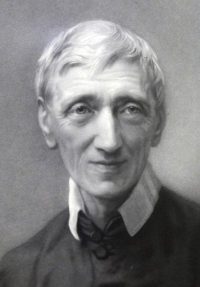
Blessed John Henry Newman is seen in a portrait provided by the Catholic Church in England and Wales. (CNS photo/courtesy of the Catholic Church of England and Wales)
WASHINGTON (CNS) — If you attended college, you probably remember the Newman Center as a place of barbecues, Bible studies and fun-loving priests trying zealously to minister to what is typically a religiously disengaged demographic.
Little known to many is that Blessed John Henry Newman, namesake of all those ministries and one of the most recent sainthood candidates to have his cause advanced by the Vatican, actually had a sweeping vision for how campuses as a whole should be run — one rooted in the underlying truth that binds faith and reason together.
On Feb. 13, the Vatican announced that Pope Francis has signed a decree recognizing a miracle attributed to the intercession of the English cardinal, clearing the way for his canonization.
Blessed Newman, who helped found two universities in his day, suggested in his most famous writing “The Idea of a University” that students ought to be exposed to a unified model of liberal education — one that begins by letting students develop their basic intellectual faculties through the study of medieval subjects such as logic or grammar, and then progress to more specialized forms of knowledge once a unifying foundation has been firmly established.
So how have Catholic universities stacked up to that vision as Blessed Newman’s canonization day nears?
[hotblock]
Bud Marr, director of the National Institute for Newman Studies and a professor of anthropology and theological ethics at Duquesne University in Pittsburgh, said that many Catholic universities are falling short because they are starting to view subjects as separate as opposed to being part and parcel of the same truth.
“A lot of Catholic universities have fallen into a division between disciplines,” Marr said, relating that the faculty and staff of many institutions were “struggling to figure out how to have a unified approach.”
In a phone interview with Catholic News Service, he said he specifically remembers a conversation he had with a science professor who “wanted to draw upon faith in the classroom but felt intimidated” because she didn’t feel like she was “staying in her lane.”
In situations like these, Marr related, “you have to take seriously what Newman said. … If you leave out theology, you’re leaving out a key part” of what should befit a proper Catholic education.
Agreeing with Marr is Patrick Reilly, president and founder of the Cardinal Newman Society, a nonprofit that supports Catholic education and research at all levels. It is based outside of Washington in Merrifield, Virginia.
Reilly told CNS in an email about the current weaknesses he sees in Catholic education, saying, “Catholic education used to be great at cultivating mind and soul. … As a society, we have lost much of our ability to reason … and sadly many of our Catholic schools and colleges have sunk into the same methods” that lead secular institutions astray.
[tower]
But fortunately, there are Catholic institutions fighting to keep Blessed Newman’s dream alive.
Marr explained that Catholic universities which utilize a “great books” curriculum are having outcomes that would make the late cardinal proud.
These kinds of programs are good at “integrating culture and Catholic thought,” explained Marr, and he mentioned by name Newman University in Wichita, Kansas, as an example: “They have core pillars to their gen ed (general education) but they are interdisciplinary and bring faith and reason together.”
For his part, Reilly talked about his society’s effort to expose students as early as possible to the intellectual rigor so cherished by Blessed Newman.
“I teach logic, rhetoric and philosophy to students as young as seventh grade. Not only do they get it, but they relish the ability to think clearly and to pick apart the mostly irrational messages they see in the media and in politics,” said Reilly.
Both men see Cardinal Newman’s confirmed miracles as an additional source of hope specifically for American Catholics, alongside his passion for Catholic education.
The miracles attributed to Blessed Newman both involve inexplicable recoveries from life-threatening medical issues, and Marr commented that “it makes sense that there is so much devotion (to Blessed Newman) here” because “both (miracles) took place in the U.S.”
According to Reilly, each case involved “American Catholics who watched EWTN shows about Newman and prayed for his intercession.”
On July 3, 2009, Pope Benedict XVI recognized the 2001 healing of a Massachusetts Catholic, Deacon Jack Sullivan, from a spinal cord disorder as a miracle resulting from the intercession of the cardinal, paving the way for his beatification Sept. 19, 2010.
The second verified miracle attributed to his intercession involved a young law graduate from the Archdiocese of Chicago who faced life-threatening complications during her pregnancy but suddenly recovered when she prayed to the English cardinal for help.
PREVIOUS: Cardinal Tobin: New ‘Nostra Aetate’ moment needed from abuse summit
NEXT: Knights of Columbus novena underway to pray for success of Vatican summit



Share this story